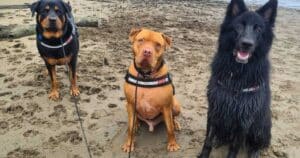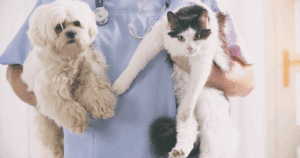
Bladder Stones in dogs and cats can cause pain and swelling, and are rather common in both, so it is important to know what signs to look out for and how to differentiate them from other urinary conditions.
Straining to Urinate: discomfort while trying to urinate
Increased Frequent Urination: A common sign.
Blood in Urine: Bladder stones can cause irritation and damage to the urinary tract, leading to the presence of blood in the urine. Gives urine a pink or reddish color.
Discomfort or Pain: This can include vocalization, restlessness, or changes in behavior, such as reluctance to be touched around the abdominal area.
Changes in Urine Color or Odor: In addition to blood, changes in the color or odor of urine may be noticeable. This can be a result of inflammation or infection associated with bladder stones.
Licking Genital Area: Dogs and cats may instinctively lick their genital area more than usual due to the discomfort associated with bladder stones.
Differentiating these signs from other urinary conditions, such as infections, can be challenging based solely on clinical signs and we generally need to perform imaging such as xrays or ultrasounds to figure it out. You can also have both at the same time. Always important to see your Vet if you notice any of theses things.
There’s a few well known factors:
Genetics – there are a few breeds that are known for bladder stones. e.g. Dalmations and Urate stones, Miniature Schnauzers and Struvite Stones.
Diet plays a big role too. Probably the biggest influence is a lack of sufficient hydration.
Minerals precipitate in concentrated urine can cause them and, on the flipside, continual flushing of the bladder will appropriately dilute the urine which helps flush out any crystals that do form. Dogs and cats on a dry food diet will be more prone if they’re not able to drink enough water.
If you compare that kibble has around 10-20% moisture, whereas a fresh diet is more like 60-80%, that’s a huge difference to ask pets to make up with drinking. Read about the role of moisture in a pet’s diet here.
Also, naturally the composition of diet. If you’re not feeding a balanced, or a highly alkaline diet, rather than a complete and balanced healthy raw diet, that can influence stone formation.
Underlying health/physical conditions such as incontinence, vulval formation – basically anything that could create a hub for infection.
Lifestyle factors, such as low levels of exercise, and reduced opportunities to urinate when left alone all day or for hours on end with no outdoor access.
I think it’s important for pet parents to have a rough gauge of how much their pet’s drink each day and their normal urinating habits. Do they usually empty one bowl or half a bowl a day. How often does your dog urinate on a walk?
That way, when something is out of the ordinary, you will be confident and be able to articulate it with your vet.
It is really important you see your vet if you notice signs we’ve spoken about such as increased frequency, straining or blood, as UTI’s are really uncomfortable, as are bladder stones, and both can be very dangerous for our dogs at cats.
Dr. Nicole Rous is a holistic veterinarian and the founder of Shy Tiger, an Australian owned pet care company. With a passion for natural and holistic health practices, she operates Mont Albert Veterinary Surgery in Melbourne, providing modern, professional and affordable health care for pets. More at Shy Tiger and Mont Albert Vet.

Dog Treat Naturals Superfood Sticks



Poor gut health and dog behaviour issues



Get your paws on Lara Shannon’s best selling books ‘Eat, Play, Love (your dog) and World of Dogs.
Available in Australia, USA, UK and Canada.